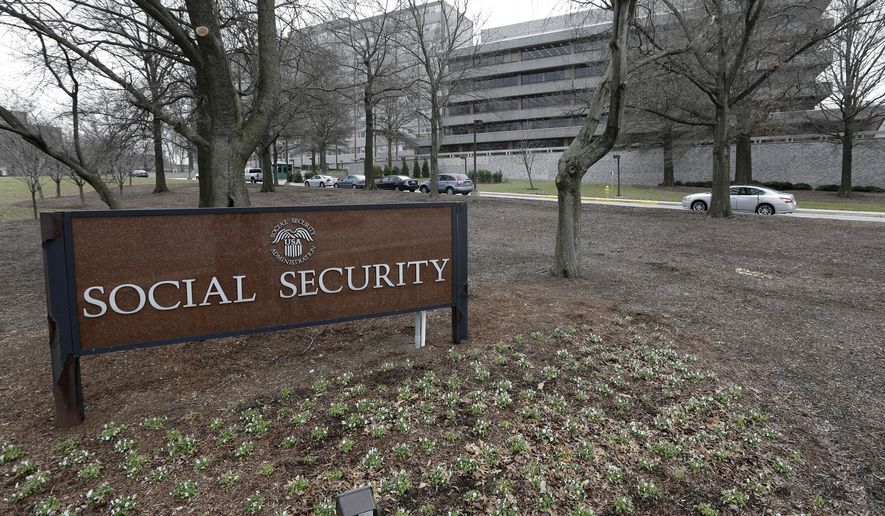Social Security will spend more than it collects this year, the program’s trustees said Tuesday, marking the first time in more than 35 years that it will run an annual deficit as it slides toward insolvency by 2034.
Medicare’s main trust fund is in even worse shape, scheduled to hit insolvency in 2026 — three years earlier than last year’s estimate, the trustees said.
The twin warnings add even more pressure to a budget already strained by last year’s tax cuts and this year’s deal to boost spending on defense and basic domestic needs, leaving few bright spots in the federal fiscal picture.
The news also produced the usual finger-pointing among Democrats and Republicans, but budget watchdogs said the news was so grim that it should cut through the bipartisan bickering.
“It would be a nice change if this year Congress and the president actually took these warnings seriously enough to do something,” said Robert L. Bixby, executive director of the Concord Coalition.
Social Security has been struggling for years and turned cash-negative this decade, meaning the government paid out more in benefits each year than it collected from the payroll tax.
But some analysts had said it was still running a surplus because of interest on the money credited to the trust fund. Now, even that crutch is gone, as even with interest revenue included the program will pay out more this year than it collects.
It’s the first time since 1982 that the program has shown an overall annual deficit.
“This is deeply troubling and should serve as a reality check for anyone concerned about the future of this important program,” said Rep. Sam Johnson, Texas Republican and chairman of the House subcommittee that oversees Social Security.
The program is slated to take in $828.2 billion this year, with most of that coming from payroll taxes. It will pay out $853.6 billion in benefits and administrative costs. That will cut the cumulative trust fund from $2.820 trillion to $2.795 trillion — a small but symbolic slide.
The Old-Age and Survivors Insurance program, the main part of the trust fund, will have its assets depleted in 2034, at which point benefits will have to be cut by more than 20 percent, the trustees said.
Rep. John B. Larson of Connecticut, the ranking Democrat on the key Social Security subcommittee, cautioned against overreacting to those numbers. He said the program “is stable financially for now” — though there are longer-term challenges.
Rather than cut benefits, he has proposed increasing the program’s payout. The higher costs would be covered by an immediate tax hike on higher-income Americans and a phased-in rate hike on everyone.
“Congress must act now because Social Security is not an entitlement; it is the insurance that they have paid for and earned,” he said.
The trustees said Social Security’s fiscal position deteriorated slightly from last year’s report. The Republican tax-cut law is sapping revenue, and President Trump’s phaseout of the Obama-era Deferred Action for Childhood Arrivals deportation amnesty for illegal immigrant “Dreamers” will also cost the system workers who would pay in benefits in the short term without being able to collect on them.
Combined, those changes bumped up the insolvency date by months.
For Medicare, the change was a three-year jump in insolvency for the hospital fund, advancing from 2029 to 2026. The trustees blamed a number of changes, including the 2017 tax cuts, which also repealed the Obamacare mandate requiring Americans to hold insurance. That will boost Medicare payouts, the trustees predicted.
“This report should eliminate any doubt that Trump’s tax law yanked Medicare closer to insolvency,” said Sen. Ron Wyden of Oregon, the top Democrat on the Finance Committee.
Republicans, meanwhile, pointed to longer-term forces: the aging population and a relatively smaller share of people in the workforce to support those seniors.
“Lackluster economic growth in previous years, coupled with an aging population, has contributed to the projected shortages for both Social Security and Medicare,” said Treasury Secretary Steven T. Mnuchin, one of the trustees.
Conservatives said the trustee reports should spur Congress to get to work on solving the imbalance.
But that means either tax increases to cover current costs — seemingly impossible after Republicans spent so much political capital passing the tax cuts — or trims to benefits. And there, the roadblock is Mr. Trump.
He vowed during the 2016 campaign not to reduce future Social Security or Medicare benefits and has repeated those instructions to his budget office now that he is president.
The longer Congress and the president wait, the rougher the changes will be. If nothing is done until the 2034 insolvency date for Social Security, benefits will be cut by 23 percent or the payroll tax will have to be raised nearly 4 percent — a massive hike that would have deep repercussions throughout the economy.
Social Security covers 62 million people, split among retired workers and their dependents, survivors of workers who have died and disabled people.
Medicare, a federal heath insurance program, covers nearly 60 million Americans, mostly seniors but some disabled Americans.
• Stephen Dinan can be reached at sdinan@washingtontimes.com.




Please read our comment policy before commenting.